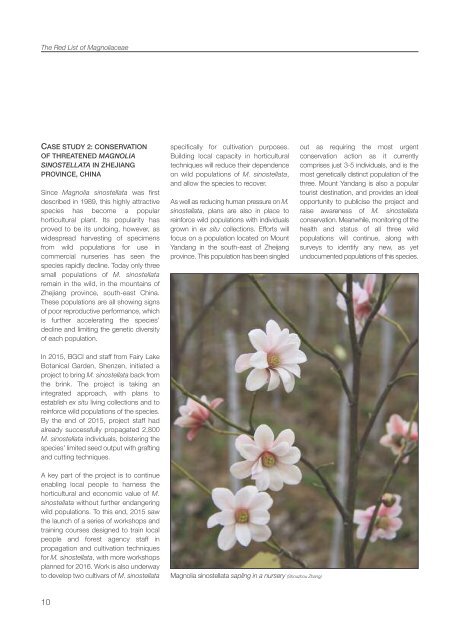Magnoliaceae
Magnoliaceae_RedList_2016_LowRes
Magnoliaceae_RedList_2016_LowRes
You also want an ePaper? Increase the reach of your titles
YUMPU automatically turns print PDFs into web optimized ePapers that Google loves.
The Red List of <strong>Magnoliaceae</strong><br />
CASE STUDY 2: CONSERVATION<br />
OF THREATENED Magnolia<br />
sinostellata IN ZHEJIANG<br />
PROVINCE, CHINA<br />
Since Magnolia sinostellata was first<br />
described in 1989, this highly attractive<br />
species has become a popular<br />
horticultural plant. Its popularity has<br />
proved to be its undoing, however, as<br />
widespread harvesting of specimens<br />
from wild populations for use in<br />
commercial nurseries has seen the<br />
species rapidly decline. Today only three<br />
small populations of M. sinostellata<br />
remain in the wild, in the mountains of<br />
Zhejiang province, south-east china.<br />
These populations are all showing signs<br />
of poor reproductive performance, which<br />
is further accelerating the species’<br />
decline and limiting the genetic diversity<br />
of each population.<br />
In 2015, BGcI and staff from Fairy Lake<br />
Botanical Garden, Shenzen, initiated a<br />
project to bring M. sinostellata back from<br />
the brink. The project is taking an<br />
integrated approach, with plans to<br />
establish ex situ living collections and to<br />
reinforce wild populations of the species.<br />
By the end of 2015, project staff had<br />
already successfully propagated 2,800<br />
M. sinostellata individuals, bolstering the<br />
species’ limited seed output with grafting<br />
and cutting techniques.<br />
specifically for cultivation purposes.<br />
Building local capacity in horticultural<br />
techniques will reduce their dependence<br />
on wild populations of M. sinostellata,<br />
and allow the species to recover.<br />
As well as reducing human pressure on M.<br />
sinostellata, plans are also in place to<br />
reinforce wild populations with individuals<br />
grown in ex situ collections. Efforts will<br />
focus on a population located on Mount<br />
yandang in the south-east of Zheijang<br />
province. This population has been singled<br />
out as requiring the most urgent<br />
conservation action as it currently<br />
comprises just 3-5 individuals, and is the<br />
most genetically distinct population of the<br />
three. Mount yandang is also a popular<br />
tourist destination, and provides an ideal<br />
opportunity to publicise the project and<br />
raise awareness of M. sinostellata<br />
conservation. Meanwhile, monitoring of the<br />
health and status of all three wild<br />
populations will continue, along with<br />
surveys to identify any new, as yet<br />
undocumented populations of this species.<br />
A key part of the project is to continue<br />
enabling local people to harness the<br />
horticultural and economic value of M.<br />
sinostellata without further endangering<br />
wild populations. To this end, 2015 saw<br />
the launch of a series of workshops and<br />
training courses designed to train local<br />
people and forest agency staff in<br />
propagation and cultivation techniques<br />
for M. sinostellata, with more workshops<br />
planned for 2016. Work is also underway<br />
to develop two cultivars of M. sinostellata<br />
Magnolia sinostellata sapling in a nursery (Shouzhou Zhang)<br />
10


